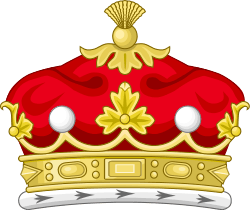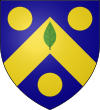Marquess of Linlithgow
| Marquessate of Linlithgow | |
|---|---|
|
Azure on a chevron Or between three bezants a laurel leaf Vert | |
| Creation date | 23 October 1902 |
| Monarch | King Edward VII |
| Peerage | Peerage of the United Kingdom |
| First holder | John Hope, 7th Earl of Hopetoun |
| Present holder | Adrian Hope, 4th Marquess of Linlithgow |
| Heir apparent | Andrew Hope, Earl of Hopetoun |
| Remainder to | the 1st Marquess's heirs male of the body lawfully begotten |
| Subsidiary titles |
Earl of Hopetoun Viscount Aithrie |
| Seat(s) | Hopetoun House |
Marquess of Linlithgow, in the County of Linlithgow or West Lothian, is a title in the Peerage of the United Kingdom. It was created on 23 October 1902 for John Hope, 7th Earl of Hopetoun.[1] The current holder of the title is Adrian Hope.
This branch of the Hope family descends from Sir Charles Hope, grandson of Sir James Hope, sixth son of Sir Thomas Hope, 1st Baronet, of Craighall (see Hope baronets). In 1703 he was created Lord Hope, Viscount Aithrie and Earl of Hopetoun in the Peerage of Scotland, with remainder to the heirs male and female of his body. He later served as Lord Lieutenant of Linlithgowshire and as Governor of the Bank of Scotland. Lord Hopetoun married Lady Henrietta, only surviving daughter of William Johnstone, 1st Marquess of Annandale (died 1721). He was succeeded by his eldest son, the second Earl. In 1763 he succeeded his kinsman as fourth Baronet, of Kirkliston (see Hope baronets for earlier history of this title).
His son from his first marriage, the third Earl, served as Lord Lieutenant of Linlithgowshire from 1794 to 1816 and sat in the House of Lords as a Scottish Representative Peer from 1784 to 1794. In 1792 Lord Hopetoun succeeded his great-uncle as de jure fifth Earl of Annandale and Hartfell, although he never successfully claimed this title. In 1809 he was created Baron Hopetoun, of Hopetoun in the County of Linlithgow, in the Peerage of the United Kingdom, with remainder to the heirs male of his father. He died without male issue and the claim the earldom passed to his daughter Lady Anne (see below and the Earl of Annandale and Hartfell for later history of this branch of the family). Lord Hopetoun was succeeded (in the barony of Hopetoun according to the special remainder) by his half-brother, the fourth Earl. He was a General in the Army, sat as Member of Parliament for Linlithgow and served as Lord Lieutenant of Linlithgowshire. In 1814, two years before he succeeded in the earldom, he was raised to the Peerage of the United Kingdom in his own right as Baron Niddry, of Niddry Castle in the County of Linlithgow, with remainder to the male issue of his father.
He was succeeded by his son, the fifth Earl. He was Lord Lieutenant of Linlithgowshire. His son, the sixth Earl, also served as Lord Lieutenant of Linlithgowshire. He was succeeded by his son, the seventh Earl. He was a prominent colonial administrator and Conservative politician and served as Governor of Victoria, as the first Governor-General of Australia and as Secretary of State for Scotland. In 1902 he was created Marquess of Linlithgow, in the County of Linlithgow or West Lothian.[2] His son, the second Marquess, was also a politician and served as Viceroy of India from 1936 to 1943. He was succeeded by his eldest twin son, the third Marquess. He was Lord Lieutenant of West Lothian from 1964 to 1985. As of 2013 the titles are held by his only son, the fourth Marquess, who succeeded in 1985.
Earls of Hopetoun (1703)
- Charles Hope, 1st Earl of Hopetoun (1681–1742)
- John Hope, 2nd Earl of Hopetoun (1704–1781)
- James Hope-Johnstone, 3rd Earl of Hopetoun (1741–1816)
- John Hope, 4th Earl of Hopetoun (1765–1823)
- John Hope, 5th Earl of Hopetoun (1803–1843)
- John Alexander Hope, 6th Earl of Hopetoun (1831–1873)
- John Adrian Louis Hope, 7th Earl of Hopetoun (1860–1908) (created Marquess of Linlithgow in 1902)
Marquesses of Linlithgow (1902)
- John Adrian Louis Hope, 1st Marquess of Linlithgow (1860–1908)
- Victor Alexander John Hope, 2nd Marquess of Linlithgow (1887–1952)
- Charles William Frederick Hope, 3rd Marquess of Linlithgow (1912–1987)
- Adrian John Charles Hope, 4th Marquess of Linlithgow (b. 1946)
The heir apparent is the present holder's eldest son Andrew Christopher Victor Arthur Charles Hope, Earl of Hopetoun (b. 1969).
The heir apparent's heir apparent is his elder son, Charles Adrian Bristow William Hope, Viscount Aithrie (b. 2001). Viscount Aithrie served as one of the Queen's Pages of Honour at the 2014 State Opening of Parliament.[3]
Other family members
Numerous other members of the Hope of Hopetoun family have also gained distinction. James Hope-Vere (son of William Hope-Vere, eldest son of the Hon. Charles Hope-Weir (1710–1791), second son of the first Earl) represented Ilchester in the House of Commons. Charles Hope (eldest son of John Hope, second son of the Hon. Charles Hope-Weir) was Lord President of the Court of Session under the judicial title of Lord Granton from 1811 to 1836. John Hope, son of Charles Hope, was Lord Justice Clerk of Scotland from 1841 to 1858. His son William Hope was a Lieutenant-Colonel in the Army and recipient of the Victoria Cross. Charles Hope (1798–1854), son of Charles Hope, Lord Granton, was a Rear-Admiral in the Royal Navy. His son Charles Webley-Hope was also a Rear-Admiral in the Royal Navy. The latter was the father of 1) Sir George Price Webley Hope, an Admiral in the Royal Navy, who was the father of Maurice Webley Hope (1901–1986), a Brigadier in the Army, and 2) Herbert Willes Webley Hope (1878–1969), an Admiral in the Royal Navy, whose son Adrian Price Webley Hope was a Major-General in the Army.
Charles Hope, son of Charles Hope (1798–1854), was a Captain in the Royal Navy. His son Frederick Hope was a Major-General in the Army. The latter's grandson Sir Peter Hope was a diplomat and served as Ambassador to Mexico from 1968 to 1972. He was also President of the British Association of the Sovereign Military Order of Malta. Sir John Hope (1765–1836) (second son of John Hope, second son of the Hon. Charles Hope-Weir) was a Lieutenant-General in the Army. His third son, Sir William Hope-Johnstone (1766–1831) was a Vice-Admiral in the Royal Navy. He married his second cousin Lady Anne Hope-Johnston, de jure 6th Countess of Annandale and Hartfell, daughter of the third Earl. Their eldest son John James Hope Johnstone (1796–1876) twice unsuccessfully claimed the earldom of Annandale and Hartfell. However, his great-great-great-grandson successfully claimed the title in 1985 (see Earl of Annandale and Hartfell).
Sir William Hope-Johnstone and Lady Anna Hope-Johnstone were also the parents of:
- Sir William James Hope-Johnstone (1798–1878), an Admiral in the Royal Navy
- Commander Charles Jame Hope-Johnstone (1801–1835), who was the father of James Charles Hope-Johnstone (1835–1884), a Major-General in the Army
- George James Hope-Johnstone (1802–1842), a Captain in the Royal Navy, whose son William George Hope-Johnstone (1830–1870) was also a Captain in the Royal Navy
Sir George Johnstone Hope, son of Charles Hope-Weir by his third wife Helen Dunbar, was an Admiral in the Royal Navy and fought at the Battle of Trafalgar. He married his first cousin once removed Lady Jemima Hope (d. 1808), daughter of the third Earl of Hopetoun. Their son Sir James Hope-Vere was an Admiral of the Fleet in the Royal Navy.
Charles Hope (1768–1828), eldest son of the second Earl from his third marriage to Lady Elizabeth Leslie, was a General in the Army. The Hon. Sir Alexander Hope (1769–1837), fourth son of the second Earl (and second from his third marriage to Lady Elizabeth Leslie), was a General in the Army and represented Linlithgowshire in the House of Commons. He was the father of 1) George William Hope of Luffness (1808–1863), Member of Parliament for Windsor from 1859 to 1863, whose son Sir Edward Stanley Hope (1846–1921) served as a Lunacy Commissioner, and 2) the Hon. James Hope-Scott, a prominent barrister, who was the father of James Hope, 1st Baron Rankeillour (see the Baron Rankeillour for more information on this branch of the family). The Hon. James Hope-Wallace, second son of the fourth Earl, was a Lieutenant-Colonel in the Army and sat as a Member of Parliament. Charles Dunbar Hope-Dunbar, grandson of the Hon. Charles Hope, third son of the fourth Earl, proved his claim to the Dunbar Baronetcy of Baldoon (created in 1664) in 1916 and became the 6th Baronet (see Hope-Dunbar baronets). Lord John Hope, younger twin son of the second Marquess, was a prominent Conservative politician and was created Baron Glendevon in 1964.
See also
Notes
- ↑ The Edinburgh Gazette: no. 11456. p. 1061. 28 October 1902.
- ↑ The London Gazette: no. 27487. p. 6734. 24 October 1902.
- ↑ English, Rebecca (4 June 2014). "Revealed: Earl of Hopetoun's son Viscount Aithrie is page boy who fainted in the middle of the Queen's speech". Daily Mail.
References
- Kidd, Charles, Williamson, David (editors). Debrett's Peerage and Baronetage (1990 edition). New York: St Martin's Press, 1990,
- Leigh Rayment's Peerage Pages
- Lundy, Darryl. "FAQ". The Peerage.

